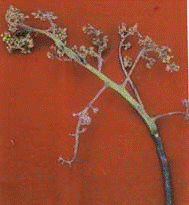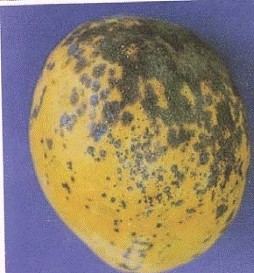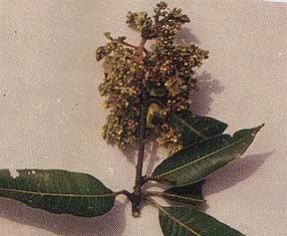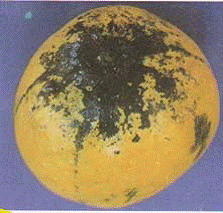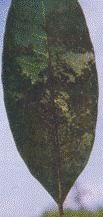आम के कुछ महत्वपूर्ण रोग
1. Powdery mildew in Mango:
Oidium mangiferae (Perfect stage: Eyrsiphe polygoni)
Symptoms
- The disease is easily recognized by whitish or grayish powdery growth on the inflorescence and tender leaves.
- Generally the infection starts from the inflorescence and spreads downwards covering the floral axis, tender leaves and stem. Infected leaves become twisted, curled and fall.
- Infected floral parts are severely damaged and drop off. If the fruits are set, they do not grow in size and may drop before attaining pea size. Fruits are sometimes malformed, discolored due to severe mildew attack.
- Because of poor fruits set and heavy flower and fruits drop, the loss due to the disease
- may be as high as 70-80%.
Management
- Two preventive sprays with wettable sulphur 0.3% before flowers open and after fruit set.
- Dusting twice or thrice with fine Sulphur.
- Spraying with Karathane 0.1% before flowering and after fruit set (peanut stage).
- Resistant varieties: Neelum, Zardalu, Banglora, Torapari-khurd and Janardhan pasand.
2) Anthracnose in Mango:
Colletotrichum gloeosporioides
Symptoms
- The fungus produces leaf spots, blossom blight, wither tip, twigs blight and fruit rot
- On leaves circular, light yellow brown spots are produced initially which soon enlarge with dark brown to black margins. If infection is severe individual spots coalesce leading to twisting of foliage and premature defoliation
- The disease spreads rapidly during rainy season and covers the tender twigs causing them to wither
- On inflorescence stalks and flowers minute spots are produced which increase in size and cause flower drop – the symptom hence is called blossom blight
- Sunken spots appear on fruits near the stem end as small brown areas that enlarge rapidly and become black. In some cases the areas involved are in the form of streaks running down from the stem end. Fruit pulp beneath the spots become hard followed by cracking and decay at ripening
- The decay is confined to the skin of the fruit except in late stages where it penetrates the flesh in shallow areas. Infected fruits may also drop off prematurely
- Latent infection is carried from the field and develops further which causes rotting in the Storage
Management
- Avoid over-crowding in orchards
- Tree sanitation is important. Diseased twigs are to be pruned and burnt along with fallen leaves and fruits
- Spray carbendazim or thiophanate methyl (0.1%) or Chlorothalonil (0.2%) at 14 days intervals from fruit set until harvest
- Before storage, treat the fruits with hot water (50-55°C) for 15 minutes or dip in Benomyl solution (500 ppm) or Thiobendazole (1000 ppm) for 5 minutes or expose them to ammonia and sulphur dioxide gases
3) Mango Malformation:
Fusarium moliliforme var. subglutinans
Symptoms
There are two types of symptoms namely vegetative malformation and floral malformation because of hypertrophic effect of Gibberellic acid produced by the pathogen
Vegetative malformation
- There is a proliferation of infected tissue. The affected plants develop excessive vegetative branches which are of limited growth, swollen and have short internodes
- These dwarf branches are of various sizes which are often produced on the top of young seedlings giving a bunchy top appearance. The axillary buds of dwarf branches are unusually enlarged
- Vegetative malformation is more pronounced in young seedlings and seedling trees than in grafted plants
Floral malformation
- The flowering panicles instead of coming out as a normal one turns into compact bunch of hard flowers. Individual flower is greatly enlarged and has a large disc
- Based on compactness of the inflorescence three types of malformations have been described
- Light malformation – light compaction of inflorescence but bears fruits
- Medium malformation – moderately compact inflorescence with discontinuous growth and no fruit set
- Heavy malformation – entire inflorescence is converted in to a compact mass of sterile flowers. Inflorescence continues to grow with flowers having hypertrophied bracts.
- The percentage of bisexual flowers in malformed panicles is very low
- The malformed heads dry up in black masses and persist on the trees for a long time
- Affected inflorescences generally are aborted and bear no fruit
Management
- Use of disease free planting material and prophylactic spray of insecticides and fungicides
- Pruning of diseased parts along with basal 15-20 cm apparently healthy portions
- Spray Benomyl or Carbendazim (0.1%).
- Spray napthelene acetic acid (NAA) 200 ppm during first week of October
4) Sooty mould disease in Mango:
Capnodium ramosum
Symptoms
- Black superficial encrustation of mass of spores of the fungus on upper surface of leaves affecting the photosynthetic activity. The fungus has no parasitic relationship with host.
- Black encrustation forms on the fruits affects appearance and hence market price
- Pathogen grows and thrives on the sugary or honey dew secretions of plant hoppers
Management
- Controlling of plant hoppers by spraying Carbaryl (2g/lt) or Phosphomidon 0.03% Spray dilute solution of starch 5% (Boil 1 kg of starch in 5 litres of water, cool and dilute to 20 litres). The dried starch comes off in flakes, removing along with it the sooty mold growth
Authors:
Avinash Parashar1, Hare Krishna2
1Ph.D. Department of Horticulture, SKRAU, Bikaner-334006
2Sen. Scientist, CIAH, Bikaner-334006
*Email:-

